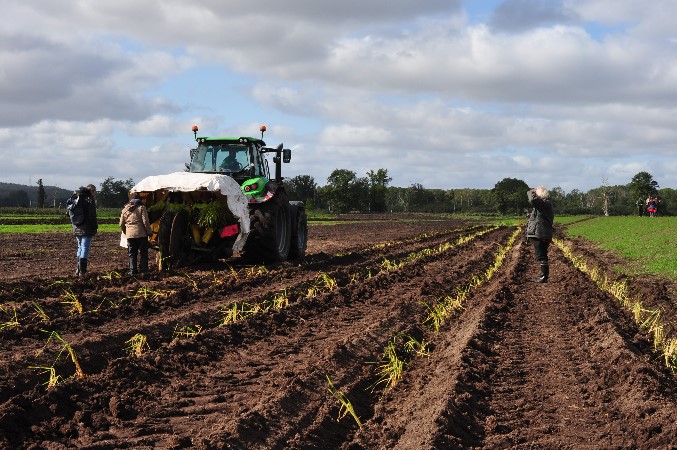The Common Agricultural Policy (CAP), which provides financial support for farmers, must safeguard and stimulate the preservation of carbon- rich soils through the protection of peatlands.
This is one of the key messages put forward in the policy brief “PEATLANDS IN THE EU. COMMON AGRICULTURE POLICY (CAP) AFTER 2020” just released by Wetlands International Europe, Greifswald Mire Centre and the National University of Ireland, Galway supported by a consortium of 23 research and civil society organisations from all across Europe. The main aim of the paper is to call for the preservation of peatlands in the post-2020 Common Agricultural Policy by:
- informing Members of European Parliament to take wise decision on CAP amendments,
- informing farmers on a new land use technique for peatlands
- getting the support of Member States to include peatlands and paludiculture (wet farming on organic peat soil) in the EU council and their strategic plans
For those not experts, what are peatlands?
Peatlands occur in all EU Member States (except Malta), often covering around or more than 10% of the land. These lands are particularly rich in organic matter. Peat accumulates in areas where the decomposition of plants is slowed due to permanent wet conditions. When kept wet, peatlands are fully functional, healthy, and the most effective long-term carbon store and sink among all terrestrial ecosystems on the planet. Over centuries, peatlands have been drained for agriculture, forestry and peat extraction. The negative consequences of this use is becoming increasingly obvious.
Why do we need to phase out drainage-based activities on peatlands?
Draining peatlands causes a substantial loss of ecosystem services such as groundwater storage, landscape cooling, and of biodiversity. The three main consequences are:
- It leads to the oxidation of the stored carbon and consequently to emission of substantial amounts of CO2.
As stated in the briefing, the EU is globally the second largest emitter of greenhouse gases from drained peatlands (220 Mt CO2eq/year). This is equivalent to circa 5% of the total EU greenhouse gas emissions. 99% of EU’s peatland emissions are caused by 16 of the 28 EU Member States. The largest peatland emitters in the EU are Germany, Finland, United Kingdom, Poland, Ireland, Romania, Sweden, Latvia, Lithuania, and the Netherlands. In most of these countries, drained peatlands contribute to more than 25 % of total emissions from agriculture.
2. It reduces local water quality through the discharge of nutrients for degrading, previously fertilised lands.
3. It leads to land subsidence (1-2 cm yearly). This results in increasing drainage costs, higher flooding risks, and – ultimately – the loss of productive land.

(Figure 3: Map showing peatland distribution across Europe indicating proportions of peatlands of the total country area pag 1 of the paper)
Why do we need to change the current CAP?
The current CAP, as implemented by most Member States, discriminates crops suitable for cultivation on wet or rewetted peatlands (e.g. reed, cattails, sedges and peat mosses) as they are not eligible for payments within the pillar I, related to direct payments to farmers. On the contrary, drainage-based agriculture with adverse environmental impact for climate, water, soil and biodiversity is supported by CAP subsidies.
Recognising paludiculture as an agricultural activity would entail that farmers willing to shift to more climate-friendly farming on organic soils could get financial support to stop drainage and restore the natural water level. This is not the case in the current CAP.
What should the new CAP include?
1 Guaranteed eligibility of farmed wet peatlands for CAP payments.
2 Phasing out CAP payments for drained peatlands.
3 Establishment of results-based agricultural payment schemes remunerating ecosystem service provision as low greenhouse gas emissions from peatlands.
More recommendations can be found in the paper below. We will keep informing and influencing the decision-making process to get a new policy, which allows farmers to opt for paludiculture and crops suitable for wet/rewetted peatlands. This will be a win-win option for nature and people.
BACKGROUND NOTES
On 1 June 2018, the European Commission published its legislative proposal establishing rules on support for strategic plans to be drawn up by Member States under the Common Agricultural Policy (CAP).
Among the nine specific objectives set up, three[1] refer to the new green architecture of the CAP. To achieve these objectives, Members States have to submit strategic plans after identifying specific national needs through a SWOT analysis and designing type of actions which will be approved by the European Commission. New elements of the proposal include: a) enhanced conditionality: a new obligation include preserving carbon-rich soils through protection of wetlands and peatlands; b) Eco-schemes, a pillar I instrument which are voluntary for farmers and mandatory for Member States.
On 2 April 2019, the AGRI Committees of the European Parliament voted on a number of amendments to the Commissions’ CAP strategic plan proposal. The main amendments adopted by the Committees in report were published on 23 May 2019. The texts approved by the AGRI and already before by ENVI Committee are currently under negotiation and have not been the subject of a EP’s plenary vote. This vote is scheduled for September/ October 2020 but subject to many changes due to COVID-19 pandemic.
If you want to know more, please download the paper in English below. Other languages (French, German, Spanish, Finnish, Romanian…) will be available soon
In English download here:

March-2020-CAP-Policy-Brief-on-Peatlands.pdf
download
- Contribute to climate change mitigation and adaptation, as well as sustainable energy
- Foster sustainable development and efficient management of natural resources such as water, soil and air
- Contribute to the protection of biodiversity, enhance ecosystem services and preserve habitats and landscapes.
